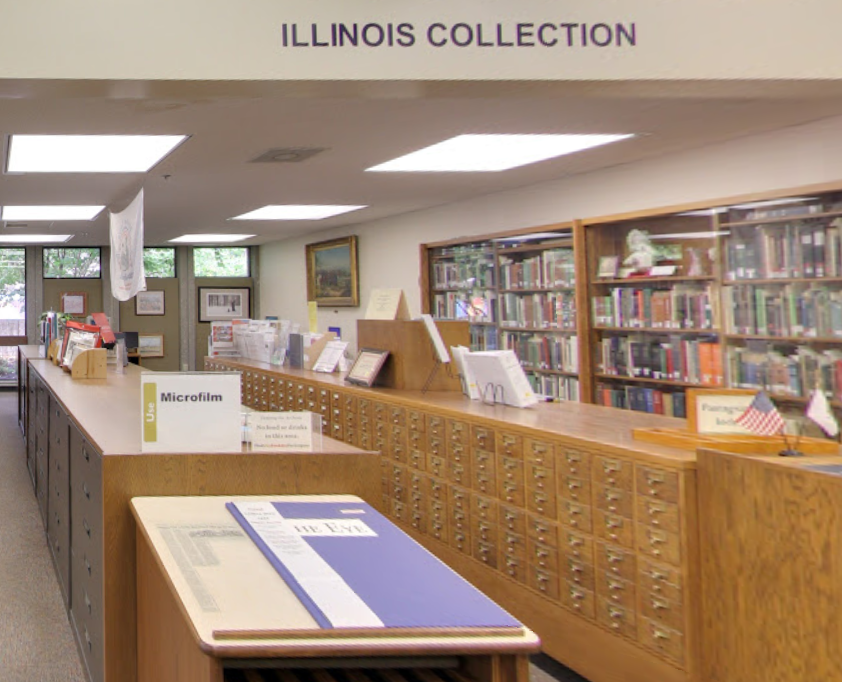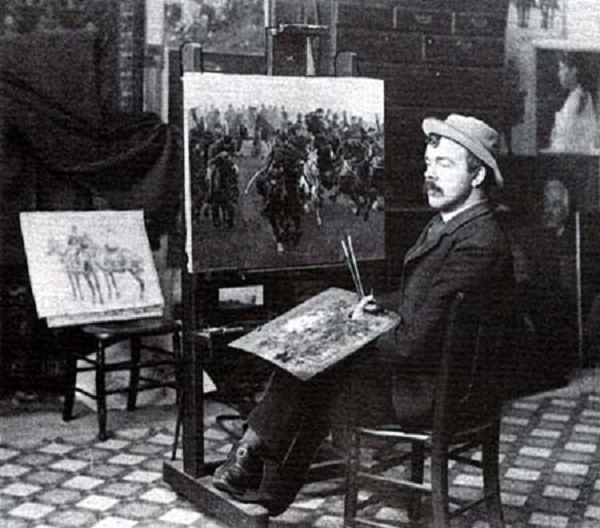At just 19 years old, painter William BT Trego burst onto the American art scene with an award-winning work at the Michigan State Fair titled Custer’s charge at Winchester– even though he was so paralyzed he could barely hold a paintbrush. It was in 1879.
Last month, this painting, which art historians believed to be lost for generations, unexpectedly appeared at an auction in Cincinnati in Hindman. The rediscovered canvas, supposed to fetch just $3,000 to $5,000sold to a private collection for $14,490 with a buyer’s premium, 190% above the high estimate, the price having risen thanks to eight competing bidders.
This is the second highest result ever obtained by the artist, according to the Artnet Price Databasejust short of the $42,000 sale of Union Army Cavalry Charge at Christie’s New York in 2007.
Where had the painting gone all these years? Hidden in plain sight, hanging near the microfilm machines in the Illinois section of the Bloomington Public Libraryabout two-thirds of the way between Chicago and Springfield.

The Bloomington, Illinois Public Library. Photo courtesy of Bloomington, Illinois Public Library.
“I was and still am stunned by the reappearance of the painting, for it had achieved a sort of legendary status among those of us who care about Trego’s work,” said Joseph P. Eckhardt, the author of the artist. recieved catalogtold Artnet News in an email.
The rediscovery also came as a surprise to Hindman, who immediately began receiving calls about the work when she released the lot listings for the March 30 auction.
“It’s always fascinating to find something thought to be missing for so many years,” Ben Fisher, vice president of Hindman and senior specialist in furniture, American folk and decorative arts, told Artnet News. “It’s just a very powerful image – you have a really good rendering of Custer on horseback with his sword raised, charging into battle. It’s just phenomenal.
Custer’s charge at Winchester was one of approximately 40 pieces from the library’s 150-work art collection that the institution chose to sell to fund an expansion and renovation project. Appraisers had taken a look in 2006 and found the signed Trego canvas to be the most valuable of the lot, but the library had no knowledge of its earlier history and importance in the artist’s work. .
The provenance of the painting has some shortcomings. Until the recent auction, the only record was that an American diplomat named John C. White bought it for $1,000 in 1884. The only thing known about him is that he was secretary of the American legation in Brazil in 1879.
“John C. White is a bit of a ghost,” Fisher admitted. “But I think the odds of him being from Bloomington are pretty strong!”

William BT Trego’s Custer’s charge at Winchester hanging in the Illinois Collection at the Bloomington, Illinois Public Library. Photo courtesy of Bloomington, Illinois Public Library.
He’s a man named Adlai Ewing – somehow related to Adlai Ewing Stevenson, vice president of Grover Cleveland, and his grandson Adlai Ewing Stevenson II, Democratic presidential candidate in 1952 and 1956 – who donated the painting to Bloomington. It is still unclear when Ewing, who died in 1920, made the gift, or when or how he acquired it himself.
“I searched well and couldn’t find any documentation. I even went through the minutes of all the library meetings,” Rhonda Massie, the library’s marketing manager, told Artnet News.
But despite the mystery, the library is delighted to have played a part in this rediscovery and with the result above the estimate of the sale.
“I thought that was pretty exciting!” Massy said.
Custer’s Charge was the first work the young artist ever exhibited publicly, and it received critical acclaim. THE Cleveland Press called it “one of the finest historical paintings of its kind ever produced by an American artist”.
Its sale gave Trego the money he needed to enroll at the Pennsylvania Academy of Fine Art, study with Thomas Eakins for three years before later moving to Paris to take classes at the Académie Julian.
This artistic success was remarkable, given that Trego had become partially paralyzed in his hands and feet after a serious illness – probably polio – when he was two years old. The son of artist Jonathan K. Trego, young Trego was fortunate that his father recognized and encouraged his talent despite these physical infirmities, encouraging him to pursue art.
“His output was not large,” Eckhardt said, “partly because of his disability and partly because he insisted on working slowly and carefully in the old academic techniques his father had taught him.”
Despite his early successes, Trego fell on hard times in his later years, especially after the death of his parents.
“Unfortunately, the quality of Trego’s artistic work and imagination reached its peak almost at the very moment when his favorite genre – military history painting – fell out of favor with the public and he discovered in the mid-1890s that sales and new orders were getting harder and harder to come by,” Eckhardt said. “Trego found himself alone in an empty house that he could neither afford nor maintain. Increasingly suffering from post-polio syndrome, and about to move in with relatives, he ended his life in June 1909.

Artist William BT Trego in his studio in 1893. Public domain, USA
It was actually a public library that led Eckhardt to Trego. When he retired from Montgomery County Community College in Blue Bell, Pennsylvania in 2007, Eckhardt donated all of his office art books to his local library in North Wales, Pennsylvania. The librarian told Eckhardt that North Wales had been home to an important American artist and shared some newspaper clippings about Trego’s life.
“I was blown away by the story of a severely handicapped artist whose talent and strength of personality had enabled him to succeed in his career at the end of the 19th century,” said Eckhardt.
He started researching Trego with the idea of writing an article. This project snowballed, and in 2011 Eckhardt organized “So Bravely and So Well – The Life and Art of William T. Trego», the first complete exhibition of the artist’s work, at the Michener Art Museum in Doylestown, Pennsylvania. The exhibition was tied to the publication of the catalog raisonné on the museum’s website, as well as a Biography by the artist of the same name.
Part of the hope for this ambitious multi-part project was that the catalog raisonné might become a resource for tracing Trego’s many works whose whereabouts had been forgotten as the artist had fallen into obscurity in his later years and more than a century later. his death.
“Over the past 12 years, several dozen have been found, including a magnificent self-portrait that Trego painted while a student under the tutelage of Thomas Eakins“, said Eckhardt.
The artist’s catalog raisonné details 179 paintings, drawings, sketches, sculptures and photographs, of which only 17 have been auctioned, making the recent sale a rarity.
“Custer’s Charge is the biggest prize we have won to date,” Eckhardt added. There is no other painting in the work of this artist that could delight me more by appearing in such an unexpected way.
Follow Artnet News on Facebook:
Want to stay one step ahead of the art world? Subscribe to our newsletter to receive breaking news, revealing interviews and incisive reviews that move the conversation forward.
